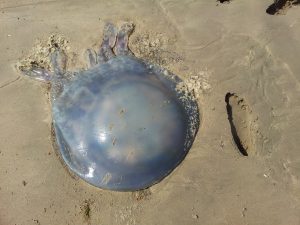Saving the small things that run the planet
Barrel Jellyfish
Fast Facts
Latin name: Rhizostoma pulmo
Notable feature: Large jellyfish with eight thick arms
Conservation Status: Not Evaluated
Where in the UK: Atlantic Ocean, generally found off the South and West Coast
Barrel Jellyfish (Rhizostoma pulmo) © Ales Kladnik
Description:

The Barrel Jellyfish (Rhizostoma pulmo) is the UK’s largest jellyfish; at its largest growing to the size of a dustbin lid (which leads to its other common name, the Dustbin-lid Jellyfish). With a large clear, sometimes translucent yellow, pink or blue, mushroom-shaped bell which covers a bunch of frilly looking tentacles below. The tentacles much resemble a cauliflower to look at. The bell has a violet-blue fringe around its edge, in place of marginal tentacles; these violet-blue fringes contain the jellyfishes sense organs.
In summer and autumn they may swarm off the coast, sometimes washing up in large numbers. These giant jellyfish swarms cause quite a stir; however they are gentle giants. Barrel Jellyfish feed entirely on tiny plankton, so their sting is too weak to hurt humans.
Jellyfish are some of the most ancient and simple animals on the planet. These bizarre creatures have drifted through our oceans for over 500 million years, despite lacking a brain, heart or blood. Their soft bodies are over 90% water, and move in a mesmerising pulsing motion operated by a simple net of nerves. Though infamous for their stinging tentacles, most species are harmless to humans.
The biggest predator of the Barrel Jellyfish is the largest sea turtle in the world, the Leatherback Turtle
-
- Size: Up to 90cm across and can weigh up to 35kgs
- Life span: The average lifespan of a normal jellyfish is around 12-18 months
- Diet: Barrel Jellyfish are carnivorous and mostly eat zooplankton
- Reproduction: Barrel Jellyfish reproduce sexually, meaning there are both male and female jellyfish; many jellyfish can also clone themselves. Once fertilised the jellyfish eggs begin their transition into planula (the free swimming larvae stage). The planula then settle into polyps (sessile/immobile stage in the jellyfish life cycle); which in turn produce baby jellyfish (or ephyrae). Progress through these stages is both food and temperature dependent. Barrel Jellyfish have been bred in captivity and their lifecycle has been studied in depth
- When to see: Adults can be seen between May and October; often found washed up on UK beaches in May and June.
- Population Trend: Unknown
- Threats: Climate change, severe weather, prey depletion from overfishing and other causes, pollution, habitat loss and degradation.
- Fun Fact: Barrel Jellyfish don’t possess lungs, heart, brain, or circulatory system.
How you can help:
Buglife is working to increase awareness of invertebrates, but we need your help!
Join a recording scheme and log your finds – send any records/sightings to the Marine Conservation Society via their report a jellyfish sighting webpage or download the iRecord app and get recording!
Do remember that we rely on donations to continue our work. If you have searched, found and learnt about our incredible invertebrates on our website, please do consider Making a Donation, Becoming a Member or maybe even making a purchase in our shop. For more ideas on how to support our work find out how to Get Involved. Thank you 🕷